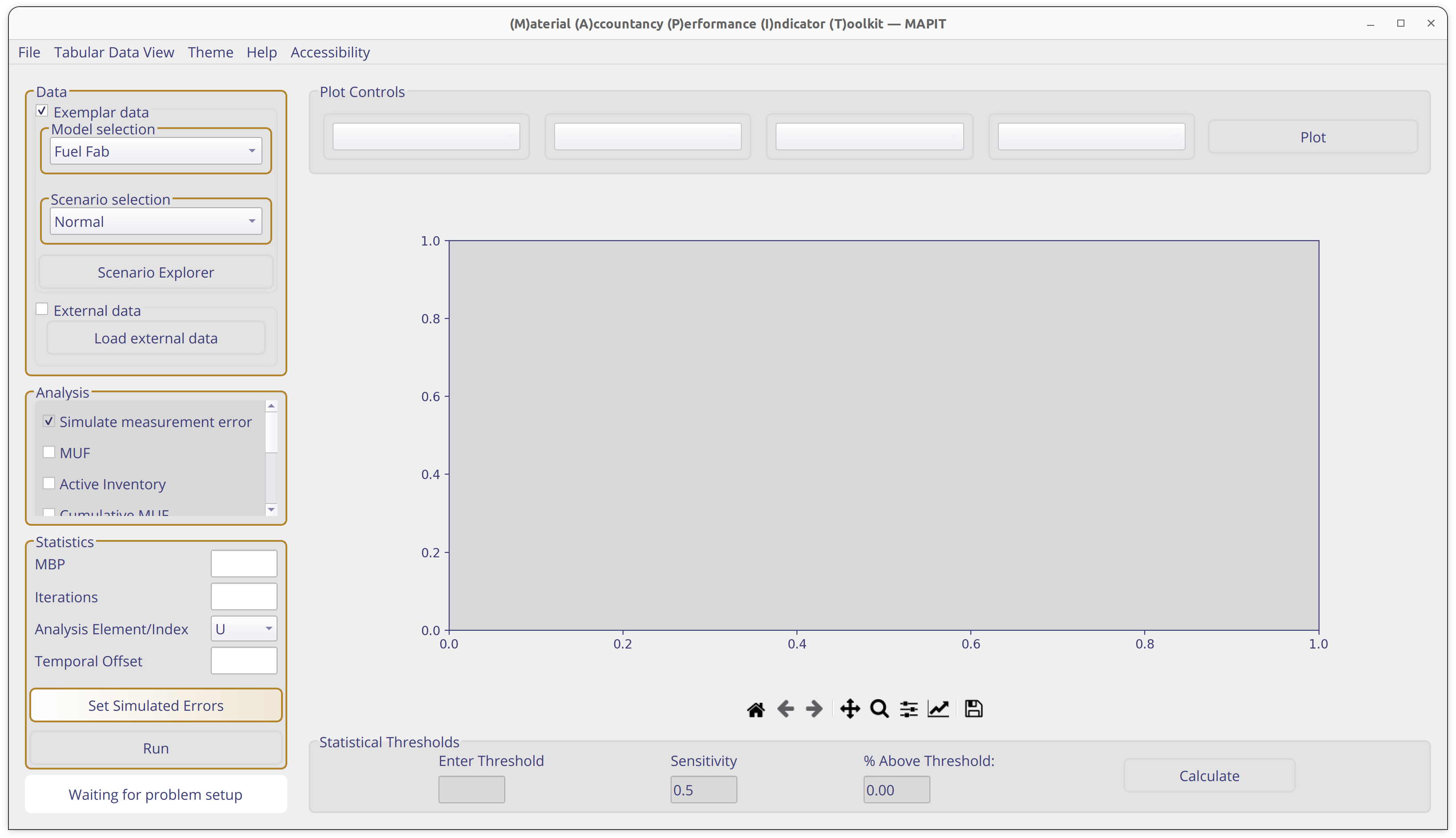Exercise 1: General MAPIT Familiarity#
Objective#
The goal of this tutorial is to gain familiarity with basic MAPIT functionality.
Note
Different stakeholders use different terminology for safeguards quantities. In some instances, the terms involve the same mathematical calculation even if the method to obtain the underlying data differs. MAPIT includes both “domestic” and “international” terminology. The following table shows terms that are mathematically equivalent. The operational and policy differences between the terms are not described here.
Generic |
International |
Domestic |
|---|---|---|
MB |
MUF |
ID |
\(\sigma\) MB |
\(\sigma\) MUF |
\(\sigma\)ID |
- |
SITMUF |
- |
- |
Page’s trend test |
- |
Opening MAPIT#
Start by launching MAPIT
If new to Python:
Windows: Run
run.batlocated in\MAPIT\windows_scriptsby double clickingUnix: Run
bash run.shin a console, ensuring that the current working directory is located in\MAPIT\unix_scripts
Otherwise:
Run MAPIT from you previously setup environment by running
MAPITfrom the command line.
Tip
If you are having trouble viewing MAPIT on your screen, try maximizing the window.
MAPIT main interface#
The main window of MAPIT should now be shown (see below for light theme example)
MAPIT has both light and dark themes available
These can be toggled at any time using the
Themedropdown menu
MAPIT allows users to control the font size
The fontsize can be changed using the
Accessibilitydropdown menu
MAPIT preferences regarding style and font size is stored internally and will be retained after closing MAPIT.
If the exemplar data has not been downloaded from the MAPIT tools repository do so now before proceeding.
If there are no options listed in the
Scenario Selectionbox of theDataarea, make sure theExemplar Databox is checked and the/path/to/datais specified correctly in File > Load Exemplar Data > Select directory.

Note
The status bar in the bottom left lets the user know what the GUI is doing at the moment. Initially when the GUI is opened it states waiting for problem setup. After data is imported, the analysis boxes are checked, statistical boxes are filled out, the simulated measurement error is specified, and Run is pressed, the bar will display the progress through the selected analyses.
Once all of the analyses have been completed, the status bar states execution finished. At this point, the user is able to use the plot controls and statistical thresholds to plot the analyses and the base data. The status bar, GUI animations, and tooltips are all used within MAPIT to help explain the safeguards analysis flow. Initially, the analyses and statistics boxes are highlighted in gold, which indicate those inputs are required for analysis.
Note
Currently, only options for statistical tests on uranium are available as it is the only element tracked in the fuel fabrication facility examples.
Performing a basic analysis#
Start by selecting
NormalforScenario selectionif not already selected.Continue by selecting the checkboxes for the following statistical tests.
MUF
Cumulative MUF
Sigma MUF
SITMUF
Page’s test on SITMUF
Next, configure required parameters in the statistical box:
MBP: 416MBP is the material balance period
For this exercise, the MBP least common multiple of the facility’s input and output stream period
Iterations: 50The number of realizations to run.
Note that in practice, only a single iterations would be observable.
If running on a lower performance device, try running with
Interations: 20
Analysis Element/Index: UMAPIT can perform statistical tests on general datasets (i.e. not just uranium and plutonium)
In such scenarios, information must be provided about the element in the dataset that tests should be performed on
Temporal Offset: EmptyIn some cases, it may be desirable to ignore a startup period
The offset rebases the calculations to a new zero
Setup errors by clicking the Select Errors button in the statistics box.
This opens the error selection pane
All errors are in percents
For example, a value of 1 is a 1% error
A recalibration period for the systematic errors, that simulates the effects of a new calibration, can also be specified.
Options are provided to adjust measurement errors for various KMPs
Users can manually enter values in the boxes
Alternatively, the drop down boxes can change all values for that measurement type automatically
For example, all random input errors can be changed at once, or all systematic errors
Some error configurations can be tedious to input. Functionality is provided to save and load configurations using the Load Error Config and Save Error Config buttons.
Tip
The default config directory can be found by using the platformdirs package as follows:
from platformdirs import user_config_dir
print(user_config_dir("MAPIT",None))
For now, select 1% errors for all values using the drop down options.
Leave the recalibration period as the default value of
None.
Press the Run button to run MAPIT
Summary#
In this exercise you learned the about the basic functionality of MAPIT:
Opening MAPIT
How to load included datasets
How to run MAPIT
How to input required parameters to run MAPIT
🎉 You have finished the first MAPIT exercise. 🎉
Continue to exercise 2.
